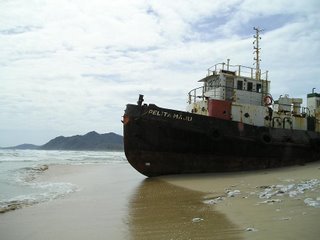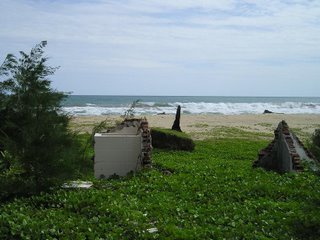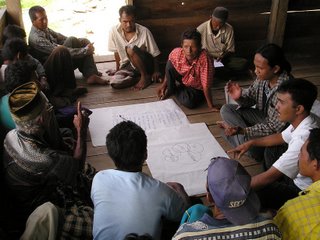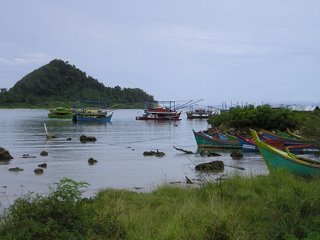June 29th - Banda Aceh
 I have had a very pleasant week.
I have had a very pleasant week.
To begin with, I enjoyed a relaxing weekend. On Saturday I went to Pantai Cemera, next to Lampuuk, not far from town, for a long walk along the beach (picture). It was wonderful; the beach is amazing and the waves can get pretty big. As it turns out, surfing is rather popular among Acehnese boys. It really is a shame that you have to swim in the ocean wearing trousers and a T-shirt because the ocean was actually very inviting. I also came across some monitor lizards on the way before winding up wandering around the remnants of what used to be a village. As you can see in the picture, everything is now covered by vegetation. I still find it strange being in the  area that was hardest-hit by the Tsunami and witnessing the aftermath with my own eyes, the sheer force of the wave is truly mind-blowing. That evening I went to a colleague’s birthday party, which was fun. On Sunday I slept in, read a couple of IRC reports and took a long nap in order to be wide awake for the
area that was hardest-hit by the Tsunami and witnessing the aftermath with my own eyes, the sheer force of the wave is truly mind-blowing. That evening I went to a colleague’s birthday party, which was fun. On Sunday I slept in, read a couple of IRC reports and took a long nap in order to be wide awake for the
Next, I spent Monday through Thursday going to the field every day. On Monday I accompanied one of the Community Driven Regeneration (CDR) teams to Lambaro Neujid where they performed a number of participatory activities with the community members. They mapped the community (community mapping) and all its institutions (institutional mapping – picture) and carried out a gender balance exercise in order determine the roles and responsibilities of men and women. It was very exciting. Unfortunately, however, the language barrier made it difficult for me to be more involved in the facilitation process. On Tuesday I joined a team of engineers going to Lhok Seudu and Layeun to assess the suitability of a water source for a water system and on Wednesday I went with another CDR team to Bireuk to help the community prioritise their problems.
order determine the roles and responsibilities of men and women. It was very exciting. Unfortunately, however, the language barrier made it difficult for me to be more involved in the facilitation process. On Tuesday I joined a team of engineers going to Lhok Seudu and Layeun to assess the suitability of a water source for a water system and on Wednesday I went with another CDR team to Bireuk to help the community prioritise their problems.
On Thursday I spoke with a few beneficiaries about a Quick Impact Programme (QIP) in Lhok Seudu, a small coastal village. QIPs are programmes designed to assist households, groups or an entire community to recover livelihoods and re-establish local economies. The beneficiaries receive a cash grant to implement various projects. During my orientation I will be looking at a number of old QIPS to gauge their sustainability. In Lhok Seudu the community chose to use the money to build a palong, a traditional fishing boat (see the big blue boat in the picture). Since the grant alone was not sufficient to cover all the expenses , the community has made an appreciable contribution to the costs. This stimulates a sense of sense of ownership, a key ingredient for the sustainability of the project. According to the agreement with the IRC, the proceeds of the palong should be split in two: half for the crew and the other half going to the community. The money for the community would be used to fund community projects. Three months after the implementation of the QIP in Lhok Seudu, I went to see whether the project is running as it was intended to. The weather permitting, the palong goes out to sea six nights a week with a crew of seven or eight. The fishermen are generally satisfied with the catches. They sell the fish to the community members and what is left over is sold at the market. As agreed, the fishermen keep half of the profits while the other half goes into a fund for community projects. Of the 50 percent for the fishermen, the captain of the palong takes ten and the remaining 40 percent is divided among the rest of the crew and of the 50 percent for the community, the treasurer keeps ten and 40 percent goes into the community fund. Everyone consents to this arrangement. In three months time, the palong has yielded a net sum of 35 million Rupiah (almost 3.700,- USD, approximately 2.800,- EUR) for the community; a sizeable amount. The money will be used to buy land so that each household can own its own propriety.
, the community has made an appreciable contribution to the costs. This stimulates a sense of sense of ownership, a key ingredient for the sustainability of the project. According to the agreement with the IRC, the proceeds of the palong should be split in two: half for the crew and the other half going to the community. The money for the community would be used to fund community projects. Three months after the implementation of the QIP in Lhok Seudu, I went to see whether the project is running as it was intended to. The weather permitting, the palong goes out to sea six nights a week with a crew of seven or eight. The fishermen are generally satisfied with the catches. They sell the fish to the community members and what is left over is sold at the market. As agreed, the fishermen keep half of the profits while the other half goes into a fund for community projects. Of the 50 percent for the fishermen, the captain of the palong takes ten and the remaining 40 percent is divided among the rest of the crew and of the 50 percent for the community, the treasurer keeps ten and 40 percent goes into the community fund. Everyone consents to this arrangement. In three months time, the palong has yielded a net sum of 35 million Rupiah (almost 3.700,- USD, approximately 2.800,- EUR) for the community; a sizeable amount. The money will be used to buy land so that each household can own its own propriety.
Finally, I experienced my first earthquake in Banda Aceh at 6:20 this morning. The quake was (unofficially) estimated to have reached 4.8 or 4.9 on the Richter scale. It is a good thing I happened to be awake at that time because I think I would have slept right through it otherwise. Still, it was the most violent quake I have ever experienced. It is an odd feeling. Also, today is the first day since my arrival that it has not rained!

0 Comments:
Post a Comment
<< Home